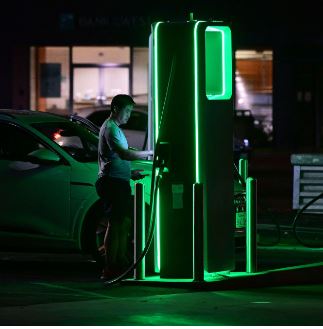With conversations initiated and revolving around climate change and a cleaner environment, sustainable transportation comes into act. Whenever we think about sustainable transportation the continuous development and bettering of electric vehicles is the only goal. Not just electric vehicles, but the consistent R&D on EV technologies like charging ports, batteries, and IoT applications in EVs tell us how important the revolution and adoption of EVs taking place in a country like India. It is equally important for the country to think about the infrastructure of an EV Charging station.
India has arrived at a critical juncture for sustainable transportation and energy. The government wants to reduce the amount of electricity produced using fossil fuels and attain zero carbon emissions from energy production. The adoption of electric vehicles and other environmentally friendly modes of transportation is a key component of the effort to make Indian mobility sustainable. Through a number of policies, the government is organizing and assisting EV-related activities.
In India, there are already 1.4 million electric vehicles on the road.
They are primarily electric rickshaws. However, there is a sharp rise in the number of personal electric vehicles. Less than 1% of all new vehicles registered in India for the fiscal year 2018–19 were electric automobiles.
By the fiscal year 2022, this percentage of EVs had risen to roughly 4%, and it has since risen quickly. The need for charging stations is rising along with the sales of personal EVs, which are on the rise. In India, there are currently over 200 cities with over 2000 electric charging stations, with Delhi leading the pack with over 90 stations.
EVs and Charging Stations
In order to allow EV drivers to cover larger distances with their vehicles while stopping to charge at these charging stations, new charging stations are being developed across the country. These charging stations’ requisite infrastructure necessitates significant financial outlays as well as qualified labor. The required high capital cost is offset by the low likelihood of any revenue sources. There are now only a few electric vehicles on the road and even fewer long-distance EV commuters.
Determining the placement of the charging stations becomes essential in order to maximize the number of consumers and increase the operator’s revenue. When designing the charging station and the associated infrastructure, it is necessary to consider a number of factors:
Location of EV charging station –
For EV owners, their residences are the best option for a charging station because they can plug in their cars there before or after a trip when they are sitting idle. Due to its convenience, this charging station is the most popular. The location of the workplace is the second favored factor. When owners get to work, they can plug in their car so it will be ready for the return trip later. When traveling across cities or large distances, charging stations are required. These stations are another name for the fueling locations for cars with IC engines. EV owners who pay a certain amount of money can charge their EVs at these stations. The choice of the station influences how little time must be lost from the original route, as well as occasionally for the availability of certain leisure pursuits to pass the time while the vehicle charges.
Holding Period for EV Charging-
EVs may require drivers to wait until the car in front has finished charging before they can move forward. Increasing the number of charging outlets at the charging station could alleviate this restriction. It can’t be increased indefinitely though because it requires more capital. People favor using stations with short wait times.
Charging time for an EV
The length of time needed for the car to be fully charged for the subsequent trip influences the owner’s choice of whether or not to use a specific charging station. Different automobiles require different inputs for charging. All types of vehicles must be catered for by the charging stations’ amenities. The time required to charge the car increases if the precise charging criterion is not satisfied.
The Expense of EV Charging
Utilizing an EV is ultimately intended to reduce operating expenses. This is especially true for those who drive farther distances in EVs. The price of charging thus assumes significance. The owner of the charging station must set the fees in a way that preserves the operational benefit of an EV. The owner of the charging station may search for additional and creative methods to charge users.
Source of Electricity
The key factor in the growing global popularity of electric vehicles (EVs) and the support of various governments is their environmentally friendly aspect. Presently, coal-based facilities produce 60% of India’s electricity. The companies who provide the charging stations must look into alternative sources of electricity. Currently, coal-based facilities generate 60% of India’s electricity (Source). The companies who provide the charging stations must look into alternative sources of electricity. Along with the electricity given by the government, solar energy can be used at the stations, allowing them to become carbon-neutral and self-sufficient.
When designing the charging station, the station owner must carefully consider the aforementioned concerns. It’s critical to comprehend the requirements and viewpoints of EV owners. Priorities must be established in advance in order to create the best model and generate the most revenue for the owner over the long and short terms.








